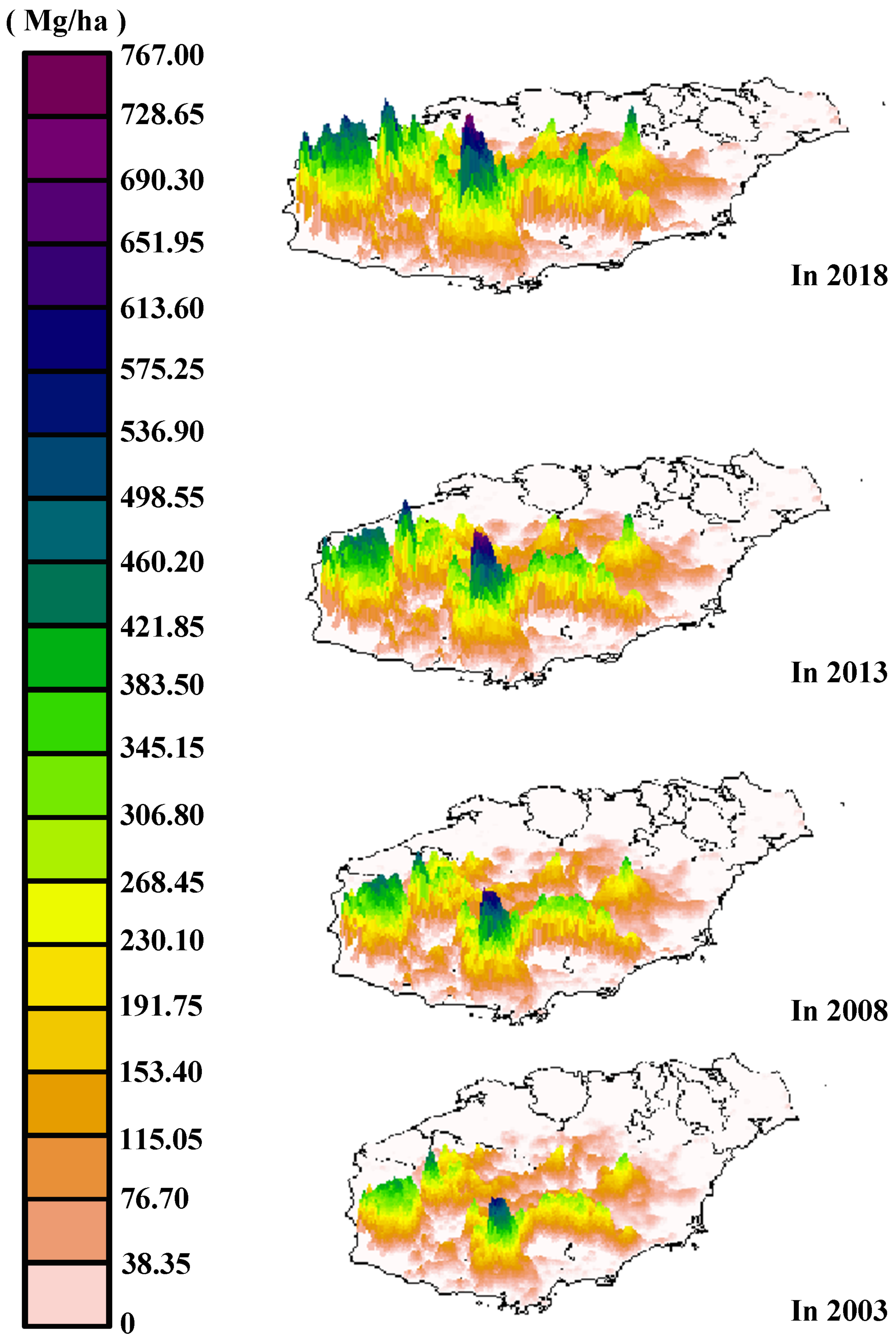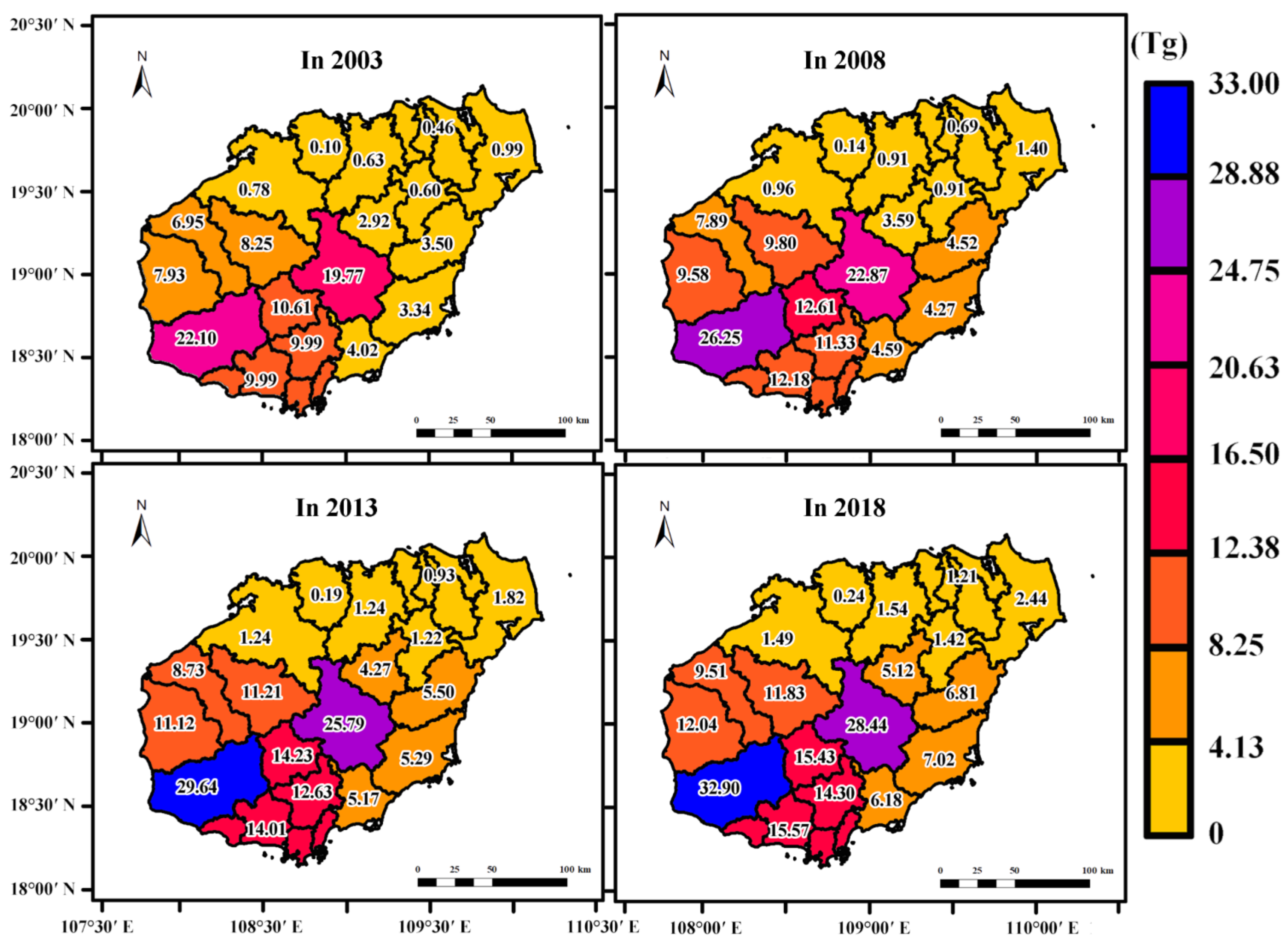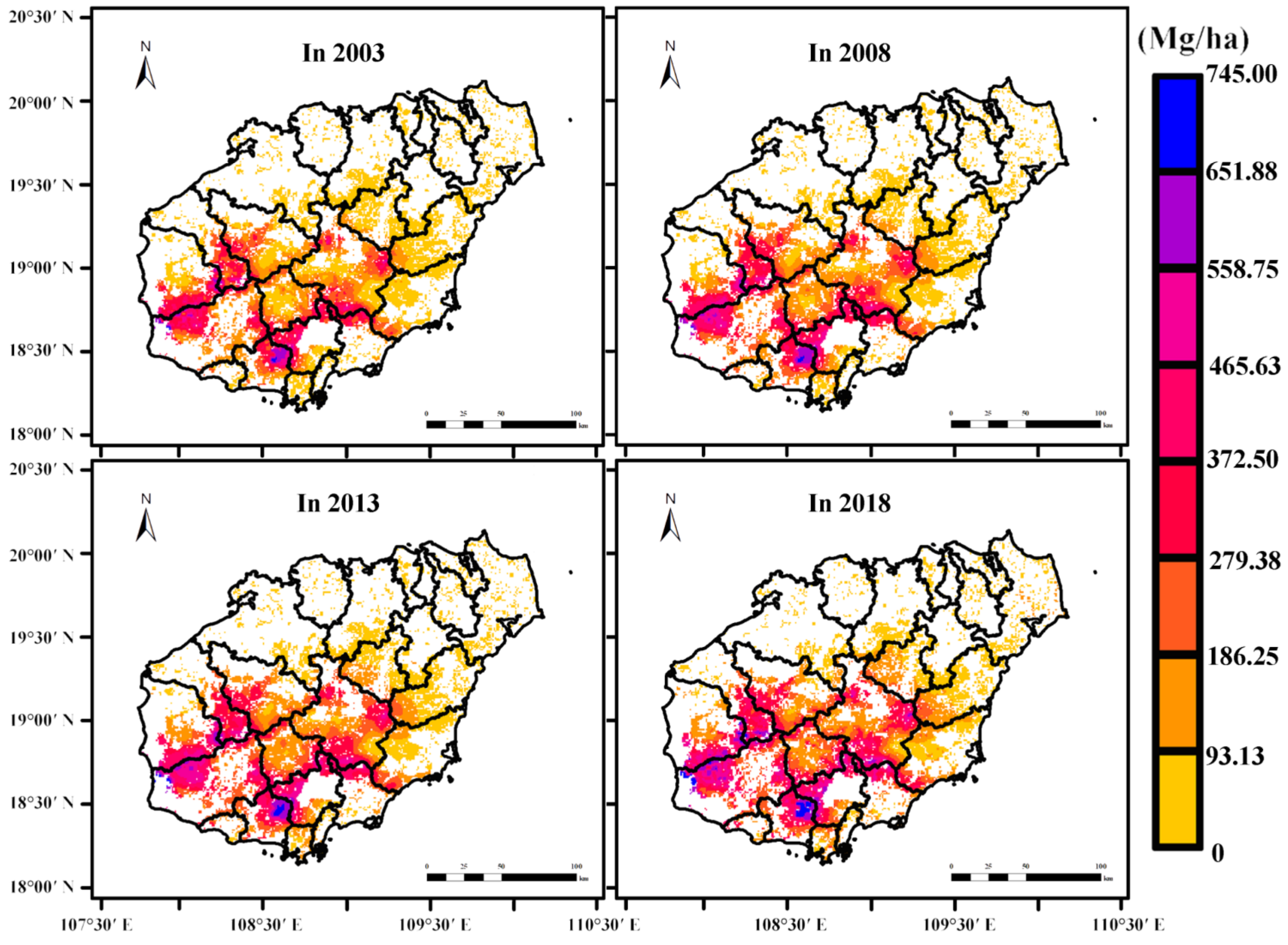Remote Sensing of Tropical Rainforest Biomass Changes in Hainan Island, China from 2003 to 2018
Abstract
:1. Introduction
2. Method
2.1. Establishment of Hainan Tropical Rainforest Database
2.2. Enhanced Vegetation Index Extraction Method Based on MODIS Product Data
2.3. Establishment of the Tropical Rainforest Biomass Estimation Model for Remote Sensing in Hainan
2.4. Data Preprocessing before Tropical Rainforest Biomass Estimation Model Fitting
3. Results
3.1. Fitting Results and Accuracy Evaluation of the Remote Sensing Estimation Model for Tropical Rainforest Biomass in Hainan
3.2. Spatial Pattern of Tropical Rainforest Biomass in Hainan
4. Discussion
4.1. Feasibility Analysis of Introducing Environmental Information to Estimate Forest Biomass
4.2. Evaluation and Analysis of the Spatial Pattern of Tropical Rainforest Biomass in Hainan
5. Conclusions
Author Contributions
Funding
Institutional Review Board Statement
Informed Consent Statement
Data Availability Statement
Conflicts of Interest
Appendix A



References
- Bhardwaj, D.; Banday, M.; Pala, N.A.; Rajput, B.S. Variation of biomass and carbon pool with NDVI and altitude in sub-tropical forests of northwestern Himalaya. Environ. Monit. Assess. 2016, 188, 1–13. [Google Scholar] [CrossRef]
- Houghton, R.; Hall, F.; Goetz, S.J. Importance of biomass in the global carbon cycle. J. Geophys. Res. Biogeosci. 2009, 114. [Google Scholar] [CrossRef]
- Lambin, E.F.; Meyfroidt, P. Global land use change, economic globalization, and the looming land scarcity. Proc. Natl. Acad. Sci. USA 2011, 108, 3465–3472. [Google Scholar] [CrossRef] [Green Version]
- Henders, S.; Persson, U.M.; Kastner, T. Trading forests: Land-use change and carbon emissions embodied in production and exports of forest-risk commodities. Environ. Res. Lett. 2015, 10, 125012. [Google Scholar] [CrossRef]
- Shi, Y.; Zang, S.; Matsunaga, T.; Yamaguchi, Y. A multi-year and high-resolution inventory of biomass burning emissions in tropical continents from 2001–2017 based on satellite observations. J. Clean. Prod. 2020, 122511. [Google Scholar] [CrossRef]
- Lu, D. Aboveground biomass estimation using Landsat TM data in the Brazilian Amazon. Int. J. Remote Sens. 2005, 26, 2509–2525. [Google Scholar] [CrossRef]
- Huang, L.; Zhou, M.; Lv, J.; Chen, K. Trends in global research in forest carbon sequestration: A bibliometric analysis. J. Clean. Prod. 2020, 252, 119908. [Google Scholar] [CrossRef]
- Dixon, R.K.; Solomon, A.; Brown, S.; Houghton, R.; Trexier, M.; Wisniewski, J. Carbon pools and flux of global forest ecosystems. Science 1994, 263, 185–190. [Google Scholar] [CrossRef] [PubMed]
- Clark, D.B.; Kellner, J.R. Tropical forest biomass estimation and the fallacy of misplaced concreteness. J. Veg. Sci. 2012, 23, 1191–1196. [Google Scholar] [CrossRef]
- Houghton, R. Aboveground forest biomass and the global carbon balance. Glob. Chang. Biol. 2005, 11, 945–958. [Google Scholar] [CrossRef]
- Foody, G.M.; Boyd, D.S.; Cutler, M.E. Predictive relations of tropical forest biomass from Landsat TM data and their transferability between regions. Remote Sens. Environ. 2003, 85, 463–474. [Google Scholar] [CrossRef]
- Thakur, S.; Mondal, I.; Bar, S.; Nandi, S.; Ghosh, P.; Das, P.; De, T. Shoreline changes and its impact on the mangrove ecosystems of some islands of Indian Sundarbans, North-East coast of India. J. Clean. Prod. 2020, 284, 124764. [Google Scholar] [CrossRef]
- Clevers, J.G.; Kooistra, L.; Schaepman, M.E. Estimating canopy water content using hyperspectral remote sensing data. Int. J. Appl. Earth Obs. Geoinf. 2010, 12, 119–125. [Google Scholar] [CrossRef]
- Ogaya, R.; Barbeta, A.; Başnou, C.; Peñuelas, J. Satellite data as indicators of tree biomass growth and forest dieback in a Mediterranean holm oak forest. Ann. For. Sci. 2015, 72, 135–144. [Google Scholar] [CrossRef] [Green Version]
- Pandey, P.C.; Anand, A.; Srivastava, P.K. Spatial distribution of mangrove forest species and biomass assessment using field inventory and earth observation hyperspectral data. Biodivers. Conserv. 2019, 28, 2143–2162. [Google Scholar] [CrossRef]
- Huete, A.; Didan, K.; Miura, T.; Rodriguez, E.P.; Gao, X.; Ferreira, L.G. Overview of the radiometric and biophysical performance of the MODIS vegetation indices. Remote Sens. Environ. 2002, 83, 195–213. [Google Scholar] [CrossRef]
- Matsushita, B.; Yang, W.; Chen, J.; Onda, Y.; Qiu, G. Sensitivity of the enhanced vegetation index (EVI) and normalized difference vegetation index (NDVI) to topographic effects: A case study in high-density cypress forest. Sensors 2007, 7, 2636–2651. [Google Scholar] [CrossRef] [PubMed] [Green Version]
- Garroutte, E.L.; Hansen, A.J.; Lawrence, R.L. Using NDVI and EVI to map spatiotemporal variation in the biomass and quality of forage for migratory elk in the Greater Yellowstone Ecosystem. Remote Sens. 2016, 8, 404. [Google Scholar] [CrossRef] [Green Version]
- Kelsey, K.C.; Neff, J.C. Estimates of aboveground biomass from texture analysis of Landsat imagery. Remote Sens. 2014, 6, 6407–6422. [Google Scholar] [CrossRef] [Green Version]
- Dube, T.; Mutanga, O. Investigating the robustness of the new Landsat-8 Operational Land Imager derived texture metrics in estimating plantation forest aboveground biomass in resource constrained areas. ISPRS J. Photogramm. Remote Sens. 2015, 108, 12–32. [Google Scholar] [CrossRef]
- Ou, G.; Li, C.; Lv, Y.; Wei, A.; Xiong, H.; Xu, H.; Wang, G. Improving aboveground biomass estimation of Pinus densata forests in Yunnan using Landsat 8 imagery by incorporating age dummy variable and method comparison. Remote Sens. 2019, 11, 738. [Google Scholar] [CrossRef] [Green Version]
- Zhao, P.; Lu, D.; Wang, G.; Wu, C.; Huang, Y.; Yu, S. Examining spectral reflectance saturation in Landsat imagery and corresponding solutions to improve forest aboveground biomass estimation. Remote Sens. 2016, 8, 469. [Google Scholar] [CrossRef] [Green Version]
- Hernández-Stefanoni, J.L.; Dupuy, J.M.; Tun-Dzul, F.; May-Pat, F. Influence of landscape structure and stand age on species density and biomass of a tropical dry forest across spatial scales. Landsc. Ecol. 2011, 26, 355–370. [Google Scholar] [CrossRef]
- Henshaw, D.L.; Stubbs, M.; Benson, B.J.; Blodgett, D. Climate database project: A strategy for improving information access across research sites. Kango Gijutsu: Nursing Technique 1998. Available online: http://www.ecoinformatics.org/pubs/guide/frame.htm (accessed on 25 April 2021).
- Nanjing Institute of Soil Science, Chinese Academy of Sciences. China Soil Science Database. 2021. Available online: http://vdb3.soil.csdb.cn/ (accessed on 1 January 2021). (In Chinese).
- Zhang, T.; Xu, X.; Xu, S. Method of establishing an underwater digital elevation terrain based on kriging interpolation. Measurement 2015, 63, 287–298. [Google Scholar] [CrossRef]
- Dong, C.; Zhao, R.; Liu, J.P.; Wang, G.X.; Wu, X.Z. Application of geographical parameter database to establishment of unit population database. Chin. Geogr. Sci. 2003, 13, 34–38. Available online: https://link.springer.com/article/10.1007/s11769-003-0058-8 (accessed on 25 April 2021). [CrossRef]
- Xie, X.; Wang, Q.; Dai, L.; Su, D.; Ye, Y. Application of China’s national forest continuous inventory database. Environ. Manag. 2011, 48, 1095–1106. Available online: https://link.springer.com/content/pdf/10.1007/s00267-011-9716- (accessed on 25 April 2021).
- Chen, D.; Li, Y.; Liu, H.; Xu, H.; Xiao, W.; Luo, T.; Zhang, Z.; Lin, M. Biomass and carbon dynamics of a tropical mountain rain forest in China. Sci. China Life Sci. 2010, 53, 798–810. [Google Scholar] [CrossRef]
- Besnard, S.; Carvalhais, N.; Arain, M.A.; Black, A.; De Bruin, S.; Buchmann, N.; Cescatti, A.; Chen, J.; Clevers, J.; Desai, A.; et al. Quantifying the effect of forest age in annual net forest carbon balance. Environ. Res. Lett. 2018, 13, 124018. [Google Scholar] [CrossRef] [Green Version]
- Justice, C.O.; Townshend, J.; Vermote, E.F.; Masuoka, E.; Wolfe, R.E.; Saleous, N.; Roy, D.P.; Morisette, J.T. An overview of modis land data processing and product status. Remote Sens. Environ. 2002, 83, 3–15. [Google Scholar] [CrossRef]
- Zhang, J.; Feng, L.; Yao, F. Improved maize cultivated area estimation over a large scale combining MODIS–EVI time series data and crop phenological information. ISPRS J. Photogramm. Remote Sens. 2014, 94, 102–113. [Google Scholar] [CrossRef]
- Wang, L. Analysis of vegetation coverage change in Huaihe River Basin Based on MODIS-NDVI and MODIS–EVI. Chin. Acad. J. 2020, 21, 438–446. (In Chinese) [Google Scholar] [CrossRef]
- Zhou, G.; Xu, D.; Yang, Y.; Liu, Z.; Fu, S. Image Automatic Registration Technology Based on IDL Programming and GCPs Image Database. Remote Sens. Technol. Appl. 2010, 5, 627–631. (In Chinese) [Google Scholar] [CrossRef]
- Qiu, Z.; Feng, Z.; Jiang, J.; Lin, Y.; Xue, S. Application of a continuous terrestrial photogrammetric measurement system for plot monitoring in the Beijing Songshan national nature reserve. Remote Sens. 2018, 10, 1080. [Google Scholar] [CrossRef] [Green Version]
- Qiu, Z.; Feng, Z.-K.; Wang, M.; Li, Z.; Lu, C. Application of UAV photogrammetric system for monitoring ancient tree communities in Beijing. Forests 2018, 9, 735. [Google Scholar] [CrossRef] [Green Version]
- Foody, G.M.; Cutler, M.E.; McMorrow, J.; Pelz, D.; Tangki, H.; Boyd, D.S.; Douglas, I. Mapping the biomass of Bornean tropical rain forest from remotely sensed data. Glob. Ecol. Biogeogr. 2001, 10, 379–387. [Google Scholar] [CrossRef]
- Rödig, E.; Cuntz, M.; Heinke, J.; Rammig, A.; Huth, A. Spatial heterogeneity of biomass and forest structure of the Amazon rain forest: Linking remote sensing, forest modelling and field inventory. Glob. Ecol. Biogeogr. 2017, 26, 1292–1302. [Google Scholar] [CrossRef]
- Sambatti, J.; Leduc, R.; Lubeck, D.; Moreira, J.; Santos, J. Assessing Forest Biomass and Exploration in the Brazilian Amazon with Airborne InSAR: An Alternative for REDD. Open Remote Sens. J. 2012, 5, 21–36. [Google Scholar] [CrossRef]
- Hansen, E.H.; Gobakken, T.; Bollandsås, O.M.; Zahabu, E.; Næsset, E. Modeling aboveground biomass in dense tropical submontane rainforest using airborne laser scanner data. Remote Sens. 2015, 7, 788–807. [Google Scholar] [CrossRef] [Green Version]
- Motlagh, M.G.; Kafaky, S.B.; Mataji, A.; Akhavan, R. Estimating and mapping forest biomass using regression models and Spot-6 images (case study: Hyrcanian forests of north of Iran). Environ. Monit. Assess. 2018, 190, 1–14. [Google Scholar] [CrossRef]
- Wang, D.; Morton, D.; Masek, J.; Wu, A.; Nagol, J.; Xiong, X.; Levy, R.; Vermote, E.; Wolfe, R. Impact of sensor degradation on the MODIS NDVI time series. Remote Sens. Environ. 2012, 119, 55–61. [Google Scholar] [CrossRef] [Green Version]
- Karkauskaite, P.; Tagesson, T.; Fensholt, R. Evaluation of the plant phenology index (PPI), NDVI and EVI for start-of-season trend analysis of the Northern Hemisphere boreal zone. Remote Sens. 2017, 9, 485. [Google Scholar] [CrossRef] [Green Version]
- Viovy, N.; Arino, O.; Belward, A. The Best Index Slope Extraction (BISE): A method for reducing noise in NDVI time-series. Int. J. Remote Sens. 1992, 13, 1585–1590. [Google Scholar] [CrossRef]
- Tian, F.; Brandt, M.; Liu, Y.Y.; Verger, A.; Tagesson, T.; Diouf, A.A.; Rasmussen, K.; Mbow, C.; Wang, Y.; Fensholt, R. Remote sensing of vegetation dynamics in drylands: Evaluating vegetation optical depth (VOD) using AVHRR NDVI and in situ green biomass data over West African Sahel. Remote Sens. Environ. 2016, 177, 265–276. [Google Scholar] [CrossRef] [Green Version]
- Jiang, Z.; Huete, A.R.; Didan, K.; Miura, T. Development of a two-band enhanced vegetation index without a blue band. Remote Sens. Environ. 2008, 112, 3833–3845. [Google Scholar] [CrossRef]
- Shen, M.; Chen, J.; Zhu, X.; Tang, Y.; Chen, X. Do flowers affect biomass estimate accuracy from NDVI and EVI? Int. J. Remote Sens. 2010, 31, 2139–2149. [Google Scholar] [CrossRef]
- Anaya, J.A.; Chuvieco, E.; Palacios-Orueta, A. Aboveground biomass assessment in Colombia: A remote sensing approach. For. Ecol. Manag. 2009, 257, 1237–1246. [Google Scholar] [CrossRef]
- Eckert, S. Improved forest biomass and carbon estimations using texture measures from WorldView-2 satellite data. Remote Sens. 2012, 4, 810–829. [Google Scholar] [CrossRef] [Green Version]
- Propastin, P.; Kappas, M.; Erasmi, S. Application of geographically weighted regression to investigate the impact of scale on prediction uncertainty by modelling relationship between vegetation and climate. Int. J. Spat. Data Infrastruct. Res. 2008, 3, 73–94. [Google Scholar] [CrossRef]
- Propastin, P. Modifying geographically weighted regression for estimating aboveground biomass in tropical rainforests by multispectral remote sensing data. Int. J. Appl. Earth Obs. Geoinf. 2012, 18, 82–90. [Google Scholar] [CrossRef]
- Sun, R.; Wu, Z.; Chen, B.; Yang, C.; Qi, D.; Lan, G.; Fraedrich, K. Effects of land-use change on eco-environmental quality in Hainan Island, China. Ecol. Indic. 2020, 109, 105777. [Google Scholar] [CrossRef]
- Wang, J.; Liu, Y. Tourism-led land-use changes and their environmental effects in the southern coastal region of Hainan Island, China. J. Coast. Res. 2013, 29, 1118–1125. [Google Scholar] [CrossRef]
- Wang, W.; Pechacek, P.; Zhang, M.; Xiao, N.; Zhu, J.; Li, J. Effectiveness of nature reserve system for conserving tropical forests: A statistical evaluation of Hainan Island, China. PLoS ONE 2013, 8, e57561. [Google Scholar] [CrossRef] [PubMed]
- Hilker, T.; Lyapustin, A.I.; Tucker, C.J.; Hall, F.G.; Myneni, R.B.; Wang, Y.; Bi, J.; de Moura, Y.M.; Sellers, P.J. Vegetation dynamics and rainfall sensitivity of the Amazon. Proc. Natl. Acad. Sci. USA 2014, 111, 16041–16046. [Google Scholar] [CrossRef] [PubMed] [Green Version]









| Environmental Information | Normalization Formula |
|---|---|
| Latitude ′ ′′) | |
| ′ ′′) | |
| Altitude (m) | |
| Annual average rainfall (mm) | |
| Annual average minimum temperature (°C) | |
| Annual average maximum temperature (°C) | |
| Slope gradient (°) | |
| Slope direction (°) | |
| Human-disturbance factor (person/ha) | |
| Soil | |
| Total nitrogen content of the soil (%) | |
| Total phosphorus content of the soil (%) | |
| Total potassium content of the soil (%) |
| Name | Parameter | Estimate | Standard Error | 95% Confidence Intervals | |
|---|---|---|---|---|---|
| Lower Limit | Superior Limit | ||||
| 9.200 | 0.910 | 7.410 | 10.990 | ||
| 413.135 | 211.089 | −2.153 | 828.423 | ||
| 79.469 | 31.004 | 18.473 | 140.465 | ||
| EVI | −0.406 | 0.329 | −1.054 | 0.242 | |
| Name | Parameter | Estimate | Standard Error | 95% Confidence Intervals | |
|---|---|---|---|---|---|
| Lower Limit | Superior Limit | ||||
| 9.800 | 0.886 | 8.057 | 11.543 | ||
| 248.635 | 95.162 | 61.386 | 435.885 | ||
| 50.643 | 16.637 | 17.907 | 83.380 | ||
| EVI | 0.555 | 0.363 | −0.160 | 1.270 | |
| Latitude | −0.667 | 0.288 | −1.233 | −0.101 | |
| Longitude | 1.992 | 0.491 | 1.026 | 2.959 | |
| Annual average maximum temperature | −1.299 | 1.114 | −3.491 | 0.894 | |
| Annual average minimum temperature | 0.133 | 0.552 | −0.954 | 1.220 | |
| Annual average rainfall | −4.411 | 1.047 | −6.472 | −2.349 | |
| Altitude | −0.138 | 0.295 | −0.719 | 0.443 | |
| Slope gradient | −0.294 | 0.190 | −0.668 | 0.080 | |
| Slope direction | −0.273 | 0.078 | −0.426 | −0.119 | |
| Human-disturbance factor | −20.616 | 7.465 | −35.304 | −5.928 | |
| −0.581 | 0.342 | −1.254 | 0.092 | ||
| −0.170 | 0.348 | −0.855 | 0.515 | ||
| Total nitrogen content of soil | 0.886 | 0.509 | −0.116 | 1.887 | |
| Total phosphorus content of soil | 1.996 | 1.088 | −0.123 | 4.115 | |
| Total potassium content of soil | 0.884 | 0.188 | 0.513 | 1.254 | |
| Researcher | Region | Used Method | Standard |
|---|---|---|---|
| Foody et al., 2001 | Forests in Borneo, Malaysia | Remote sensing data, Artificial neural networks | |
| Sambatti et al., 2012 | Pará, Brazilian Amazon | Assessing forest biomass and exploration in the Brazilian Amazon with airborne InSAR | |
| Hansen et al., 2015 | Amani Nature Reserve located in the East Usambara Mountains in eastern Tanzania, tropical submontane rainforest | Airborne Laser Scanning | |
| Rödig et al., 2017 | Amazon rainforest | Remote sensing data, An individual-based forest model | |
| Motlagh et al., 2018 | Hyrcanian forests of north of Iran | NDVI, RVI and TVI; Spot-6 satellite images and regression models | |
| Bhardwaj et al., 2016 | Sub-tropical forests of northwestern Himalaya | NDVI, the relationship was derived through different functions simultaneously. | |
| Shen et al., 2010 | Haibei Alpine Meadow Ecosystem Research Station | NDVI, EVI, a linear spectral mixture model. | |
| Anaya et al., 2009 | Colombia is a tropical country in northern South America | EVI, allometric relationships | |
| Eckert et al., 2012 | Soanierana Ivongo District of Analanjirofo Region | Spectrum, texture, EVI, the simple linear model, usually fitted by ordinary least squares methods (OLS) | |
| Propastin et al., 2008 | Central Sulawesi, Indonesia | NDVI, precipitation, geographically weighted regression model | |
| Propastin, 2012 | Central Sulawesi, Indonesia | Multispectral remote sensing data, altitude information, GAWR model, developed stratum-specific allometric equations |
Publisher’s Note: MDPI stays neutral with regard to jurisdictional claims in published maps and institutional affiliations. |
© 2021 by the authors. Licensee MDPI, Basel, Switzerland. This article is an open access article distributed under the terms and conditions of the Creative Commons Attribution (CC BY) license (https://creativecommons.org/licenses/by/4.0/).
Share and Cite
Lin, M.; Ling, Q.; Pei, H.; Song, Y.; Qiu, Z.; Wang, C.; Liu, T.; Gong, W. Remote Sensing of Tropical Rainforest Biomass Changes in Hainan Island, China from 2003 to 2018. Remote Sens. 2021, 13, 1696. https://doi.org/10.3390/rs13091696
Lin M, Ling Q, Pei H, Song Y, Qiu Z, Wang C, Liu T, Gong W. Remote Sensing of Tropical Rainforest Biomass Changes in Hainan Island, China from 2003 to 2018. Remote Sensing. 2021; 13(9):1696. https://doi.org/10.3390/rs13091696
Chicago/Turabian StyleLin, Meizhi, Qingping Ling, Huiqing Pei, Yanni Song, Zixuan Qiu, Cai Wang, Tiedong Liu, and Wenfeng Gong. 2021. "Remote Sensing of Tropical Rainforest Biomass Changes in Hainan Island, China from 2003 to 2018" Remote Sensing 13, no. 9: 1696. https://doi.org/10.3390/rs13091696
APA StyleLin, M., Ling, Q., Pei, H., Song, Y., Qiu, Z., Wang, C., Liu, T., & Gong, W. (2021). Remote Sensing of Tropical Rainforest Biomass Changes in Hainan Island, China from 2003 to 2018. Remote Sensing, 13(9), 1696. https://doi.org/10.3390/rs13091696








